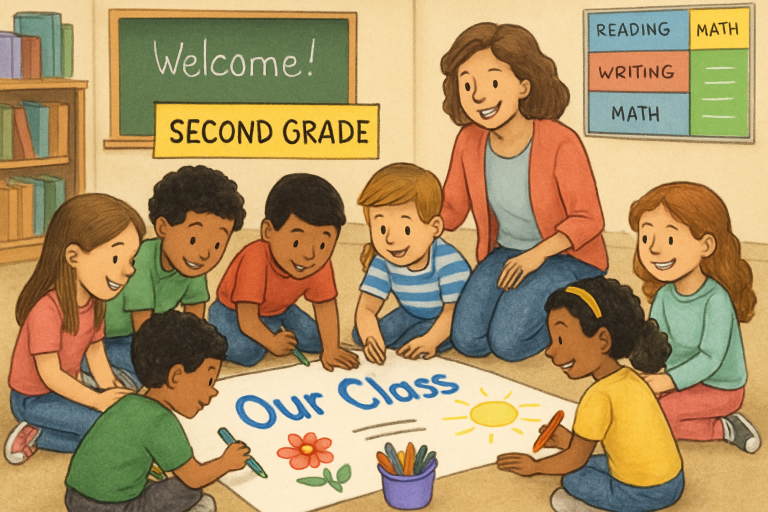Table of Contents
- Introduction
- Interactive Writing Sessions
- Visual Storytelling
- Writing Through Play
- Incorporating Technology
- Peer Collaboration
- Personalized Writing Prompts
- Celebrating Student Work
- Conclusion
Introduction
Second grade marks a pivotal time in a child’s writing journey, where skills and confidence are built through encouragement and innovation. Teachers looking to nurture budding writers will find that imaginative strategies turn hesitant scribblers into enthusiastic storytellers. By weaving in collaborative projects, playful exercises, and innovative digital tools, educators can inspire young students to communicate their ideas with both clarity and creativity. Explore engaging lesson plans at https://studentreasures.com/teachers-lounge/lesson-plans/second-grade/ for even more ways to enrich your writing curriculum.
Effective writing instruction involves tapping into students’ curiosity and making each new skill meaningful and fun. By strategically using visuals, interactive play, and personal connections, teachers can turn writing time into one of the most anticipated parts of the school day.
Emphasizing creativity helps keep learners attentive and eager to discover the power of their own voices. Practical approaches such as peer editing, using visual cues, and incorporating digital resources can unlock potential and make foundational writing skills stick. For broad educational writing strategies, consult Edutopia’s writing resources, which provide research-based advice and classroom-tested ideas for writing instruction at all levels.
Interactive Writing Sessions
Interactive writing transforms the classroom into a collaborative environment where students and teachers create written pieces. Sitting in a circle, the teacher begins a sentence and guides students as they take turns adding their contributions. The teacher reinforces key writing conventions in real-time by modeling correct spelling, punctuation, and structure. This hands-on approach also allows students to practice drafting sentences and stories, helping them internalize critical skills through direct involvement and immediate feedback.
Practical Tips
- Assign roles (sentence starter, illustrator, editor) to each student during a group project.
- Use whiteboards or smart boards to display and modify text as a group.
- Ask guiding questions to encourage critical thinking about word choice and sentence flow.
Visual Storytelling
Children are naturally drawn to pictures and often use artwork to express their thoughts before they can easily write them down. Harness this tendency by presenting them with a single image, a sequence of images, or even wordless picture books. Invite students to craft a narrative based on what they see, encouraging them to describe the setting, imagine what happens next, and invent dialogue for characters. This not only sparks imagination but also helps students understand the structure of a story.
Ideas for Application
- Create a “mystery picture” activity where students build a story around an intriguing or unusual image.
- Challenge students to draw their own sequence of events before turning them into written stories.
Writing Through Play
Integrating playful scenarios into writing lessons turns abstract assignments into tangible experiences. Role-play games like running a ‘restaurant’ or a ‘post office’ draw students into real-world writing situations. Young learners can create menus, write orders, or fill out friendly postcards, naturally developing their writing skills in enjoyable yet purposeful ways. These activities also help children see the relevance of writing in everyday life and build their confidence in using language creatively.
Incorporating Technology
Digital tools and apps can make writing lessons interactive and appealing. Platforms that offer creative writing prompts, digital books, and collaborative story-building activities can cater to different learning styles and keep lessons current. Some technologies provide instant feedback, which is invaluable for formative assessment. For teacher-approved digital resources, see Tech & Learning’s overview of 826 Digital, a platform offering over 1,000 creative writing prompts and resources.
Peer Collaboration
Writing in pairs or small groups fosters a supportive atmosphere where students can share ideas and learn from one another. Group storytelling and peer editing build communication skills and reinforce positive, constructive feedback. Collaborative projects boost writing proficiency and enhance listening skills and empathy, as children learn to value different perspectives and writing styles.
Strategies for Success
- Pair students to write and illustrate a story together.
- Set up “peer editing stations” where students can exchange drafts and offer positive suggestions.
Personalized Writing Prompts
Every student brings unique experiences and preferences to the classroom. Designing prompts around their interests—a favorite animal, a recent adventure, or a beloved family tradition—inspires personal investment and greater enthusiasm for writing. When possible, allow students to select from a list of prompts or challenge them to develop their ideas. This choice increases relevance and agency, making writing sessions more meaningful and productive.
Celebrating Student Work
Recognition and celebration are crucial for developing a lifelong appreciation for writing. Displaying student work on bulletin boards or creating a published class book gives authors a sense of pride and accomplishment. Hosting “writing showcases” where students read their stories aloud can motivate them to work hard and share their voices with the class community.
Classroom Celebration Ideas
- Display a “Writer of the Week” spotlight.
- Compile and bind favorite stories into a class anthology.
- Organize a family “publishing party” where students share their writing with loved ones.
Conclusion
Teaching writing to second graders offers endless opportunities for creativity and growth. Educators can nurture skilled, confident young writers by using interactive, visual, playful, and technological strategies—paired with encouragement and celebration. The goal is to foster writing proficiency and a genuine love for storytelling and self-expression that students will carry with them for years to come.






